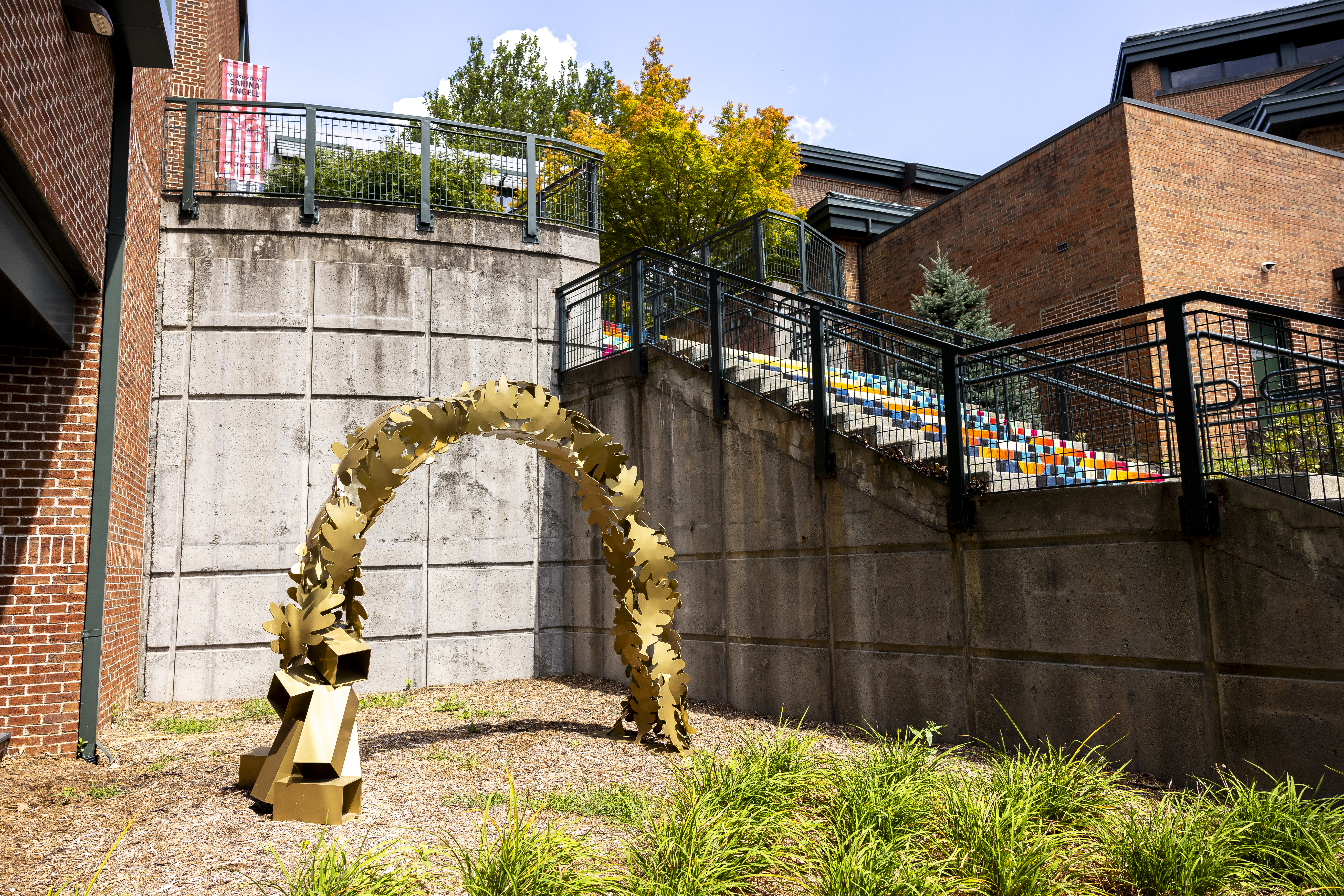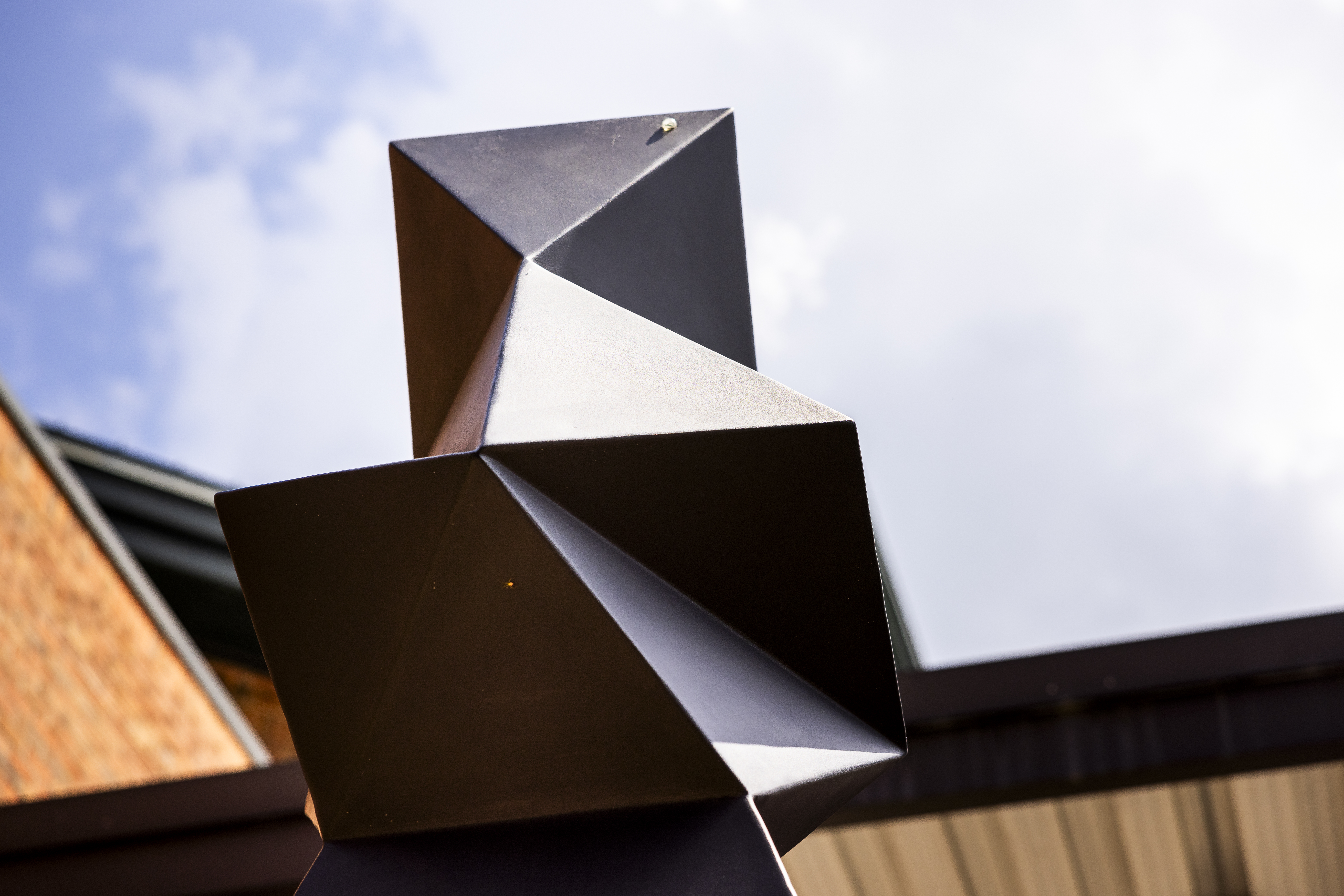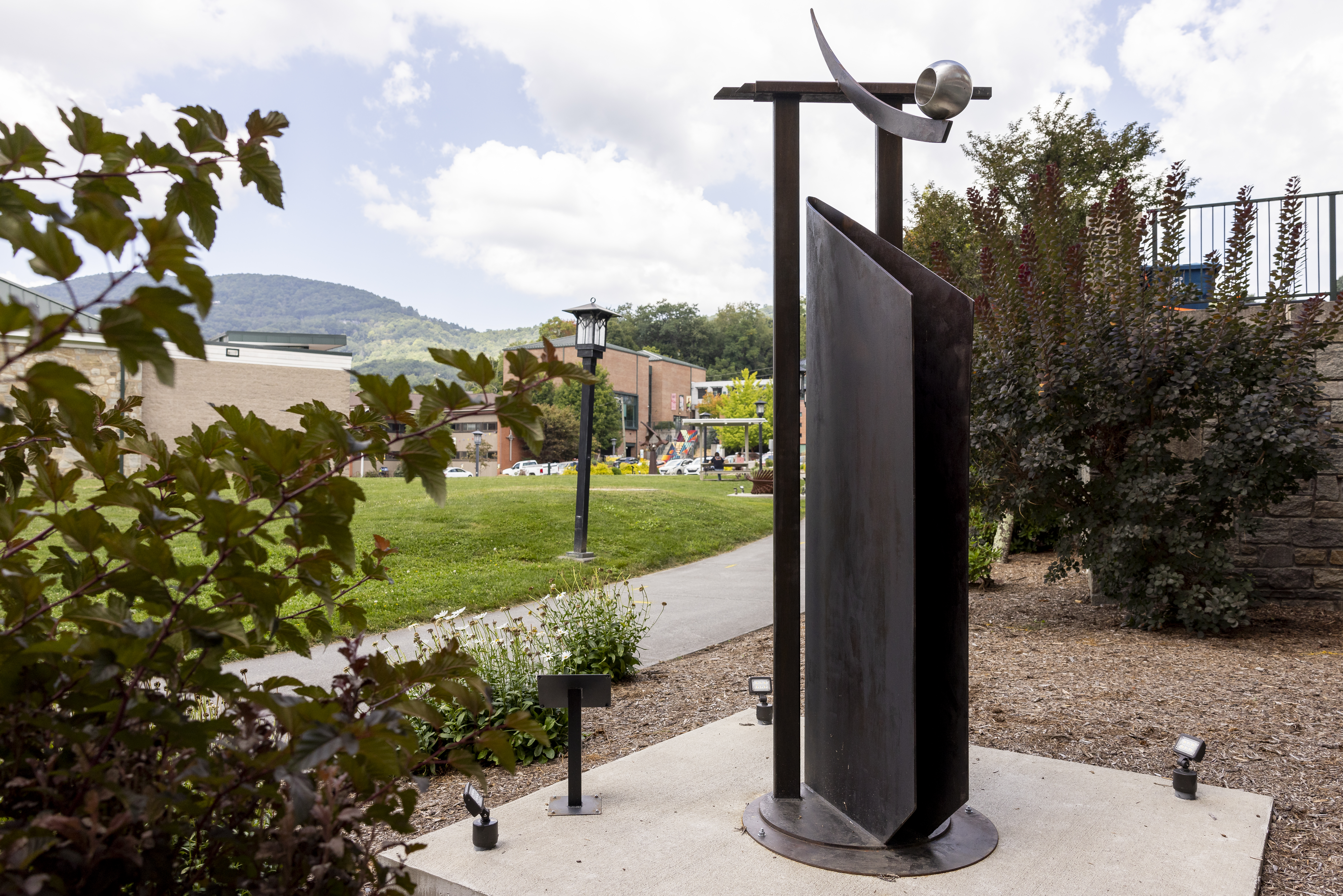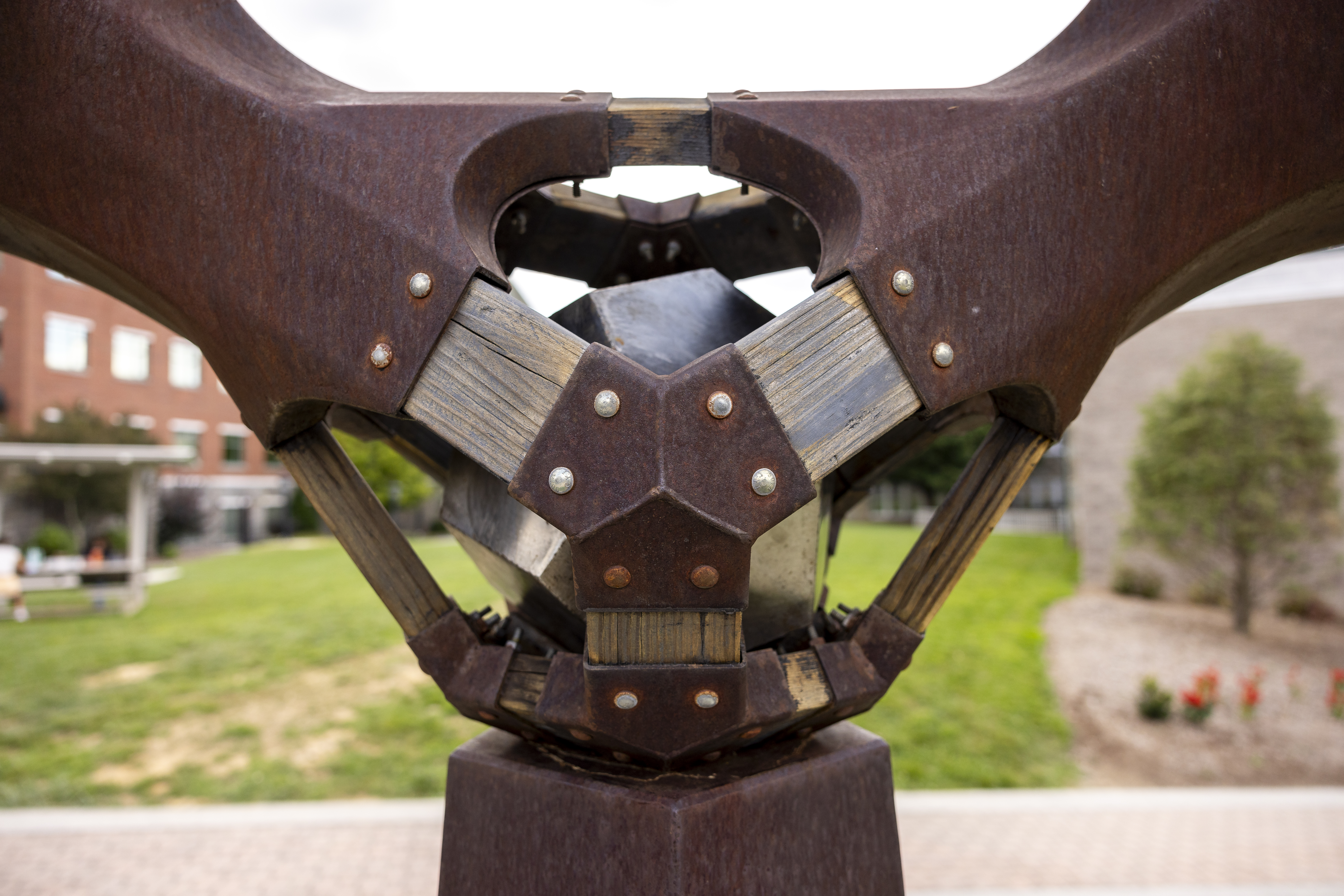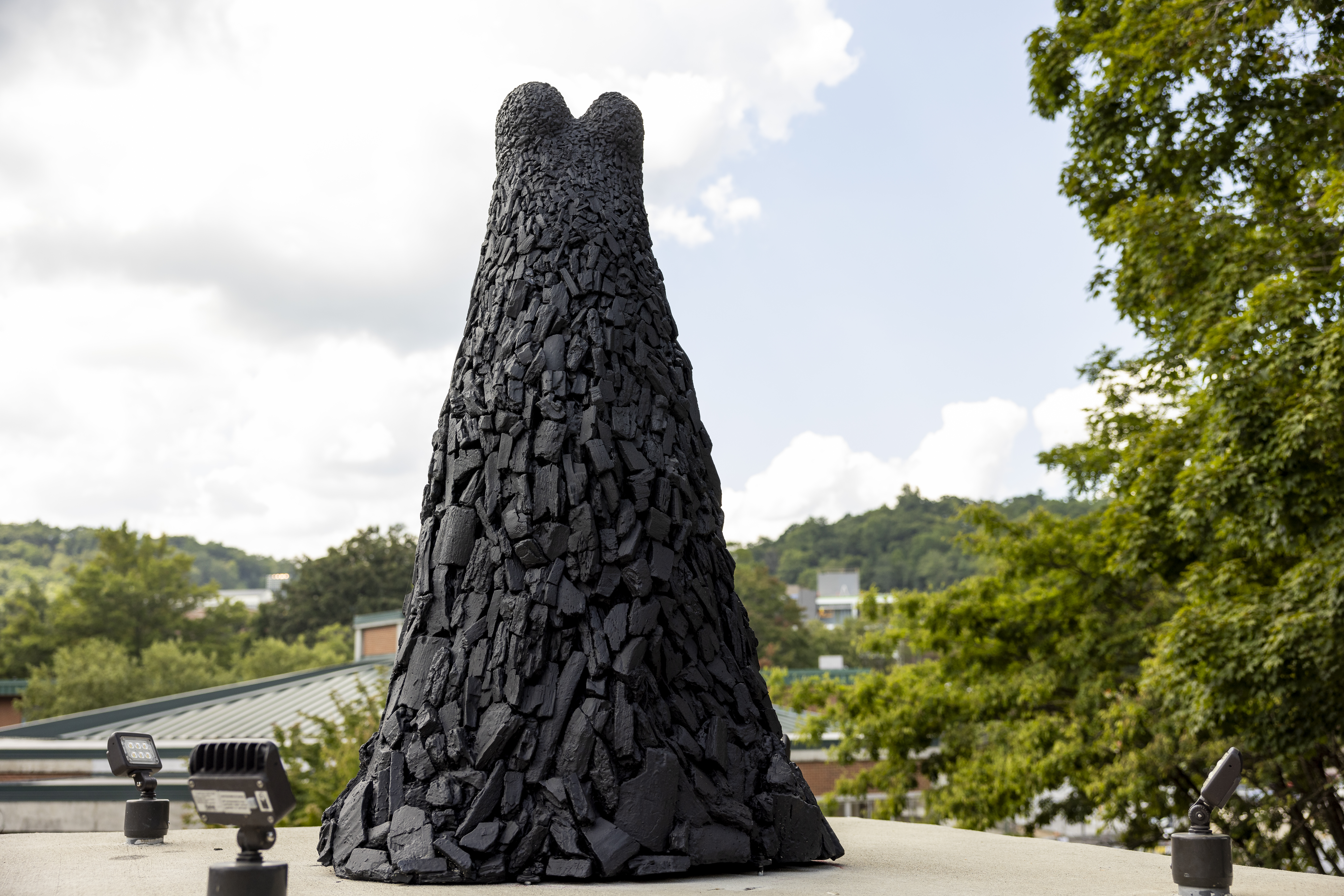Sculpture has long been a dynamic element on the campus of Appalachian State University and in August 2024, a new collection of seven sculptures have been installed as second installation of the Campus Arts Corridor. They originate at the Turchin Center for the Visual Arts on King Street and extend into campus along a public art pathway. The concept of the Campus Arts Corridor arose out of a desire to visibly link App State’s arts related venues. Two of the main university arts centers — the Turchin Center for the Visual Arts, and the Schaefer Center for the Performing Arts, are located on opposite sides of campus with numerous arts related buildings located between these two hubs. The Schaefer Center is App State’s state of the art 1660 seat venue and is home to a multitude of campus and community events, as well as visiting artists from across the region, nation and the globe. Valborg Theatre is home to the University Theatre Mainstage; Chapell Wilson Hall houses the Department of Theatre and Dance; Wey Hall contains the Department of Art; and the Broyhill Music Center houses the Hayes School of Music. The Turchin Center for the Visual Arts features six dynamic galleries with changing exhibitions of contemporary art works by national and international artists, as well as the finest local artists of the region. Situated on King Street at the crossroads of Appalachian State University and downtown Boone, the Turchin Center anchors the arts corridor and serves as a crossroads between campus and community and provides a link to the public art initiatives of the town.

Bill Brown, Breakaway
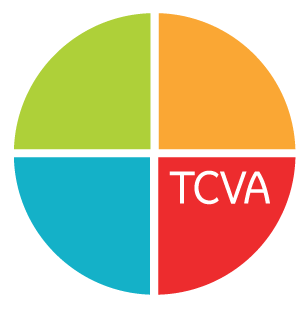
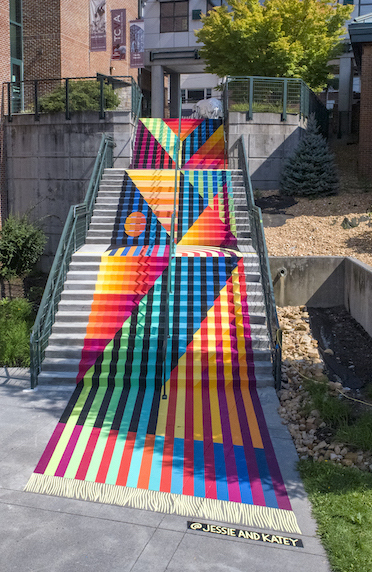
Golden Arch
Jim Gallucci
Greensboro, NC
Artist Statement
The arch is a perfect form to capture a theme for this work. Invented in ancient times by the Etruscans and perfected by the Romans, it defies gravity and cultivates wonder through its form. The arch defines a space by the position of two touch-down points, where they rest. An arch defines time as a passage through a portal. The movement gives one a concrete grasp of time. My sculpture uses the fascination of an arch to celebrate the magnificence of nature using a simple form, the leaf.
Artist Biography
I have been a sculptor for 40 years and work full time designing and creating/fabricating sculptures in my Greensboro studio assisted by a staff of 6 people. My commissions can be found in public, corporate, and residential spaces throughout the country.
In 2020, I completed an entrance piece for a Public Library in Charlotte, NC, called Open Mind, Open Book. I also worked on a NEA funded restoration project, which included 12 decorative iron gates designed and fabricated for a greenway.
I primarily use stainless steel as my medium of choice but also have used steel, bronze and other materials throughout my career. I strive to create works that are not only accessible to the public, but also inspire them. I believe my work is appropriate because I create site-specific work and I am comfortable with the scale and scope of this project.
Seeing Beyond, 2024
Mary-Ann Prack
Jefferson, NC
Artist statement
I am deeply fascinated by the essence of being human. The process of transforming a raw material such as clay into works that possess human qualities has intrigued me for four decades. I create abstractions of the human figure with a distinctive visual language of form, color, line, and texture. Although my sculptures share similar characteristics each stands alone in this world, expressing my appreciation and awe in the profound differences between us.
Artist Biography
Mary-Ann Prack is a Canadian abstract sculptor and painter. As a third-generation member of an architectural engineering family, art and architecture were integral to her early life experiences and surroundings. This foundation nurtured her passion for the arts and her interest in the Abstract Expressionist Movement. Prack began her formal fine art education at the University of Guelph in Canada, the Art Institute of Ft. Lauderdale, and Florida Atlantic University, where she discovered the medium of clay. Mary-Ann predominantly creates abstract figurative sculptures that are distinctive, precise, and characterized by geometric purity of surface and form. Beyond their physical beauty, her sculptures express profound human qualities and emotions. In 2004, a temporary health setback led Mary-Ann to explore painting, which has since become an equally vital aspect of her artistic expression, seamlessly integrating with her sculptures to create a vibrant artistic synergy.
Prack’s sculptures and paintings are featured in collections across the United States and Canada. She resides in Jefferson, NC, where she maintains her home, studio, and sculpture garden.
Raven
Vandorn Hinnant
East Grimesland, NC
Artist Statement
“Raven” has several stories. Each can be viewed independently from the other.
The upper half of this work grows out of my interest and involvement with the five Platonic Solids: five unique and interrelated polyhedrons made of regular polygons. This part of the sculpture represents the upper body of the bird and is associated with the air element.
Ravens have long factored into the mythological landscapes of humans around the world and are summed up as magical creatures associated with the forces of creation and are seen as being symbolic of transformation.
Artist Biography
From the beginning of my journey as artist, my work has been an attempt to record and convey ideas. Communication is the central theme of these works. I understand these geometries to be imbued with a natural intelligence akin to that of the mineral kingdom.
I offer these geometries as evidence of the eternal verities known to the builders of ancient civilizations. I choose to think of these works as sculptural evidence of the organizing principles present in Nature and understood by some in terms of the Golden Ratio. The sciences have brought us closer to the understandings of the builders of ancient civilizations. We are now able to scientifically verify the influence of specific geometric patterns on matter.
The Golden Ratio, present throughout Nature and employed by artisans from antiquity, has become the point of reference for each of the works of art that I bring into existence. By building on what the ancients discovered and engaged, I am one of a group of individuals dedicated to upholding a design ethic congruent with the harmonic spatial frequencies found throughout the natural world.
Each of these works of art are carefully composed utilizing design principles congruent with the generative forces of Nature. In so doing, these inherent harmonic spatial frequencies resonate with living organisms in the environments in which they are placed.
The understandings referenced here have factored into many of the ancient architectural structures that stand today. These understandings, serving as a foundation for what is brought forth, guide and govern my every act of creating.
Coming Around
Robert Winkler
Asheville, NC
Artist Statement
As a sculptor, my interest is in encounters between controlled and spontaneous, the relationship between geometric and organic.
My goal is to manipulate volume, mass and balance to create a sense of movement, through the manipulation and repetition of identical geometric forms. Creating dramatic, unwinding gestures through the use of repetition and incremental gradation allows me to achieve animated forms that engage the viewer with their power and illusion of movement.
As people walk past and around one of my sculptures, they are offered a different view from each angle as the form appears to move and change. The use of negative space creates an illusion of lightness in the structure as well as enabling interaction with the surrounding environment through the movement of light and shadow.
Artist Biography
In 2003, when Robert Winkler moved his studio from Brooklyn, NY to Asheville, NC, collectors in both cities were curious to see how the change of scenery would be reflected in his new work.
The first test arrived before the moving boxes were unpacked, when he was invited to participate in a project for that year’s Venice Biennale. Not surprisingly, the piece he submitted was a continuation of the forms he had been exploring since the early ‘90s and continues to explore today.
What defines Robert’s work is his ability to manipulate volume, mass and balance to create a sense of movement, achieving serpentine, animated forms without a single curved cut.
Born in 1947 in Cleveland, Ohio, he has pursued his art for most of his life. By the age of seven, he was attending art classes at the Cleveland Museum of Art. He went on to study ceramics, painting and sculpture at various schools, including the Cleveland Institute of Art, Ohio State University and the School of Visual Arts in New York. Widely traveled, the countries and cultures he experiences continually inform his work.
An internationally exhibited sculptor, Robert is a passionate proponent of public art. His sculpture is collected by corporations, museums and private individuals.
Breakaway
Bill Brown
Linville Falls, NC
Artist Statement
I was fortunate to grow up with a daily connection to the arts; exposed to, and participating in, the creative process with established and emerging artists. This foundation of artistic experience and knowledge began my life-long artistic exploration.
I have been a full-time studio sculptor from 1978 to the present. I divide my artistic energy between creating individual sculptures, and sculptural commission work.
My work is included in private collections throughout North America. Museum exhibitions, invitational, and gallery shows have included examples of my sculpture.
The sculpture I create is an artistic transformation of life experiences, and my interpretation of the natural and spiritual world around me. My work involves the exploration of the plasticity of steel, and the challenges of transforming materials, thought, and energy into art.
Artist Biography
Bill Brown is something of a regional legend, he is a sculptor and painter who lives and works in Linville Falls. He was born in Wilmington, Delaware in 1955 and moved with his parents to Penland, North Carolina in 1962 when he was 7 years old. Bill has participated in artists’ residences at the Penland School of Crafts, the Windgrove Center in Australia, and the Vermont Studio Center. His sculptures are featured in many private and public collections and have appeared in numerous museums and galleries exhibitions across the United States. Bill has participated in artists’ residences at the Penland School of Crafts, the Windgrove Center in Australia and the Vermont Studio Center. He often shares his extensive knowledge of sculpture at various conferences and educational facilities.
Nexus
Sam Spiczka
Artist Statement
When I look at a natural creation, be it a bone, shell or tree, I am struck by the anomalies and variations found in an object that appears symmetrical at first glance. The perfection that life aspires to is forced to adapt into a more irregular and complex form when it encounters an indifferent environment. Yet the ideal still lies just below the surface. It is a whisper only our mind can hear. My sculpture is inspired by this conflict between an ideal state and an imperfect reality. In it can be found both the chaos of growth and the geometry of perfection.
Artist Biography
Inspired by natural bone forms, rural technology, and geometric structure, Sam Spiczka has produced an unsettling body of work that is both modern and intensely primal, public yet deeply personal. Born and raised in rural Minnesota, Spiczka became captivated by metal early on through the experience of working at his family’s welding shop. Though he briefly studied art and philosophy at Gustavus Adolphus College in St. Peter, MN, his true education has come from Nature, the example of past sculptors, and the craftsmanship of his father. His award winning sculptures have been exhibited internationally – including at DeCordova Museum and Sculpture Park, Seolbong Park in Icheon, South Korea and Franconia Sculpture Park – and can be found in many public and private collections.
Martyr Dress
Jennifer Hecker
Artist Statement
My work always starts with a recognizable form— in this case a strapless gown. It is that recognizable form that is the entryway into the work, and where that entrance leads is where the art lies. It is a place discovered through making analogies between forms and ideas, through using physical matter to realize spiritual concepts, and by allowing metaphors to bring meaning into the realm of the mundane. As a sculptor, materials are the vocabulary with which I speak. Martyr Dress #1 is made of lump charcoal, which turns the black gown into a funeral pyre and speaks to the transience of beauty, youth, and life itself. There are 2 other Martyr Dresses in the series—one that looks like a wedding dress and is made of eggshells meant to symbolize fertility, and the other made of broken glass which sparkles like jewels but are only broken bottles and jars, commenting on the seduction of wealth and material possessions. The Martyr Dresses have a relationship to hair shirts worn by religious ascetics as a form of offering or penance.
Artist Biography
Jennifer Hecker has an extensive and diverse exhibition record that includes solo exhibits, commissions, collaborative installations, public art projects, outdoor sculpture displays, adjudicated exhibitions, and permanent collections. Her works were included in the 9th , the 25th , and the 29th Rosen Outdoor Sculpture Exhibitions on the campus of Appalachian State University, and in 2023 she served as the juror for the 37th Rosen competition. She also had a solo exhibition of her sculptures in The Turchin Center for the Visual Arts in 2016, entitled “The Waterworks.” Jennifer is a professor in the Department of Art at SUNY Brockport, where she has taught all levels of sculpture as well as general education art courses since 1989.
For more information on the art of Jennifer Hecker, please visit her website at: https://jenniferhecker.net/
For those who want to learn more about the sculptures in the Arts Corridor and Rosen Outdoor Sculpture Competition and Exhibition from the artists themselves, download a mobile audio guide on the free app, Bloomberg Connects. Users can select “Boone, NC” from the list of active tours to begin a self-guided audio tour through the campus of Appalachian State University. The app is available in the Apple App Store and Google Play.

